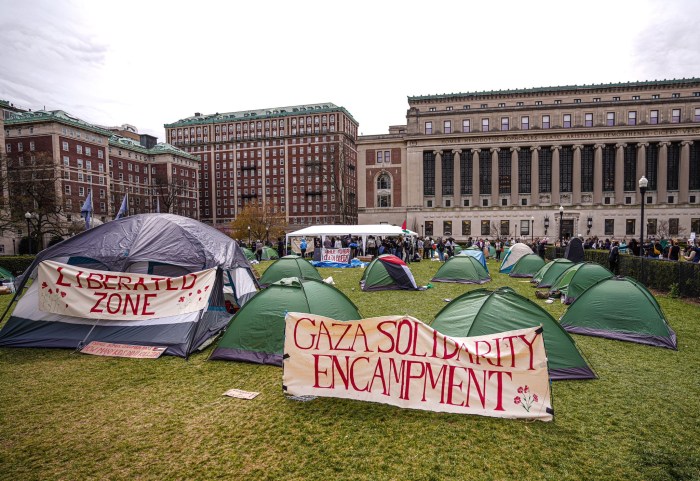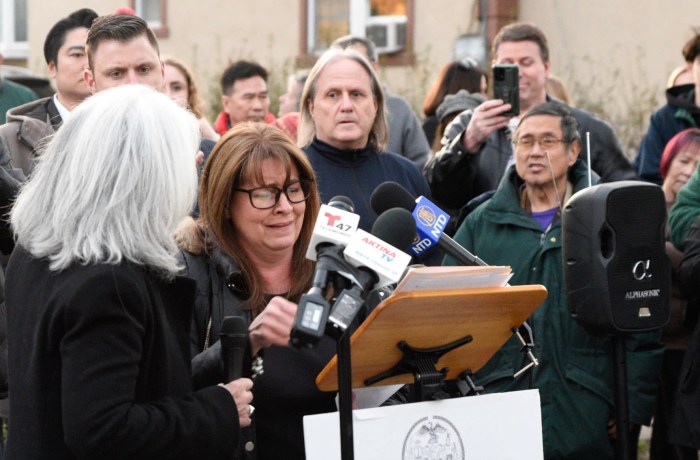
BY LINCOLN ANDERSON | As reality hit home after Monday night’s hurricane that an extended blackout was in store, Downtowners who had stayed put began foraging for emergency supplies and figuring out how they were going to make it through the ordeal.
With power cut south of 39th St. and cell phones losing their charges, or unable to find a signal, there was scant access to information.
Walking at the corner of 14th St. and First Ave. late Tuesday afternoon, Mike Schweinsburg, who has worked on many local political campaigns, was starting a northward trek in search of a functioning A.T.M. to get cash.
Summing up the challenge that residents faced, he said, “The cumulative effect of no power, no heat, no hot water, no phone.” Many people still at least had their land lines working, but Schweinsburg said, “Unfortunately, the Verizon substation is in my basement on Eighth St. – so, no phone.”
At least he had running cold water, and he added, “Gas is working, but you’ll have to hand-light it.”
Buildings of six stories or less did have running cold water, since H2O – coming down from the Upstate reservoirs – naturally rises to that level. But buildings above that height mostly did not have running water, since it needs to be lifted to a rooftop water tank by electric pump, and then is gravity-fed to apartments. So Stuyvesant Town didn’t have water, at least not as of late Tuesday afternoon. Water had come on briefly there on Tuesday, though, long enough for quick-acting residents to fill up their tubs and pots.
Georgette Massarella said she’d just overheard while passing a car radio that the blackout might last for four days.
“I’m running low on candles,” she said.
Schweinsburg told her that three blocks east at Avenue B a store had some, and was also still selling the hard-to-find “D” flashlight and radio batteries, which always fly off the shelves during blackouts and emergencies. However, Jim Wise, 77, of Stuy Town said the merchant had jacked up the price for two “D”‘s to $5.50.

“I said, ‘Why are they so expensive,'” Wise recounted. “He said, ‘They just went up.’ … That hurts the people.”
Like many in the East Village, Schweinsburg and his neighbors had heard the loud bang from Con Ed’s E. 14th St. power plant before they were plunged into darkness.
“Just as somebody said, ‘I don’t think we have to worry about power because we’re so close to Con Ed’ – crack! and lights out,” he said.
Alistair Heffernan, an N.Y.U. physics graduate student who lives in Stuy Town, had been out photographing the floodwaters on Avenue C when he heard the Con Ed plant explode — and the sky turned green, he said. He said there were six more bangs – that lit the sky a light green – after the last of which the neighborhood went black.
“Just this huge green light,” he said. “Pure green across the whole sky. I was 20 feet away from the power plant.”
Similarly, Allan Drury, a Con Ed spokesperson said a reporter actually had asked him if the explosion gave off a blue light, though YouTube videos showed the explosion and fire as orange.
David Wells said that as the salt water rose around the cars at the east end of 14th St., it switched their headlights on underwater, adding to the surreal quality.
There were no traffic lights either south of 39th St., creating an extremely dangerous situation. Tuesday afternoon, a volunteer dressed all in black and wearing a black knit cap was doing a good job directing cars and buses at the busy intersection of 14th St. and First Ave.
“Let’s go! You’re blocking my traffic!” he yelled at an inattentive driver. M.T.A. buses were running without any fare.
A man who identified himself as Chaplain Rodriguez was standing watching the unidentified volunteer, concerned.
“Last year, I did it here [during Hurricane Irene]. They give me lights,” he said, gesturing how he flicked the batons. “I almost got killed.”
Local merchants pitched in with free or discounted fare. The restaurant 11 B was giving away pizza slices on Tuesday. Veniero’s was selling its famous pastries for just $1. Stromboli’s pizza on St. Mark’s Place was going strong with a generator, and people were finding their way there by “following the pizza boxes” of customers who were taking out.
Carol D. said she had been housesitting for a friend on E. Seventh St. between Avenues C and D when the flash flood poured inside. She waded across Avenue C in freezing water almost up to her chest.
“I went back today,” she said on Tuesday. “All the antique furniture and books were floating.”
As darkness fell on Avenue A, the Bistro Truck was doing a brisk business near Seventh St. selling Belgian fries and light French fare. Its light was virtually the only illumination on the pitch-black avenue. Earlier in the day, Ray of Ray’s Candy Store had been selling iced coffees, cookies and candy bars, but had finally gone home to take a rest.
The much-derided “piss phone booth” on the corner had become a vital lifeline since people could barely get “one bar” on their cell phones.
Wearing a headlamp and walking his dog Harry, James Mona said he’d been up to a Duane Reade in Midtown to recharge his phone, sitting on the floor for two hours with his cell plugged into an outlet.
“Forty other people were doing it,” he said.

Melissa Bishop, 32 and recently newly homeless, was proud that she’d been able to sleep outside through Sandy, having found a safe spot nearby at the bottom of a stairwell below Lantern Thai restaurant.
“I had a mat, two military sleeping bags and a garbage bag on top,” she said. But she was disappointed that no homeless outreach workers from B.R.C. had been seen around since the hurricane struck.
Usually, she sleeps other places, like “under the ‘V”s,” as she put it, at the new Cooper Union building.
Thousands were going through caffeine withdrawal without their daily cup or cups of Joe. Helping to fill the need, Danielle Baskin, a recent N.Y.U. graduate who custom paints bicycle helmets, was selling cups of home-brewed coffee for a dollar from a cart.
“I’ve sold 39 cups of coffee so far,” she said, noting she’d only gotten the idea to do it about three hours earlier.
A local named Kaos was keeping her company on the dark streets.
“Anyone gets around her gets their face smashed in,” he said, brandishing tattooed knuckles in the dim glow of the Bistro Truck’s light.
Some people were telling her it was a great idea, but it was getting a little late for coffee, though they really hoped she’d be back out there the next morning.

















